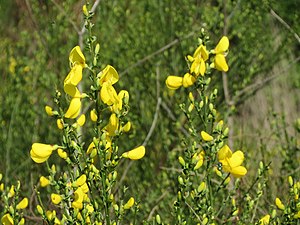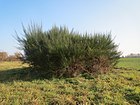Note: This is a project under development. The articles on this wiki are just being initiated and broadly incomplete. You can Help creating new pages.
Difference between revisions of "Cytisus scoparius"
| (3 intermediate revisions by the same user not shown) | |||
| Line 1: | Line 1: | ||
| − | + | [[File:20140417Cytisus scoparius1.jpg|thumb|right]] | |
| − | + | '''Cytisus scoparius''' is a perennial leguminous shrub. It is native to Europe, including Britain, from Scandanavia south to Spain, east to Poland and Hungary. | |
==Uses== | ==Uses== | ||
| − | {{Uses|}}, {{Uses|}}, {{Uses| | + | {{Uses|Heart complaints}}, {{Uses|Blood loss}}, {{Uses|High blood pressure}}. |
==Parts Used== | ==Parts Used== | ||
| − | {{Parts Used| | + | {{Parts Used|Flowers}}. |
==Chemical Composition== | ==Chemical Composition== | ||
| Line 17: | Line 17: | ||
===Dravya=== | ===Dravya=== | ||
===Rasa=== | ===Rasa=== | ||
| − | |||
===Guna=== | ===Guna=== | ||
| Line 49: | Line 48: | ||
==Mode of Propagation== | ==Mode of Propagation== | ||
| − | {{Propagation|}} | + | {{Propagation|Seeds}}, {{Propagation|Cuttings of half ripewood}}. |
==How to plant/cultivate== | ==How to plant/cultivate== | ||
| − | <ref name="How to plant/cultivate"/> | + | Landscape Uses:Border, Container, Foundation, Massing, Specimen. Succeeds in most soils, preferring a fairly good but not rich soil.<ref name="How to plant/cultivate"/> |
==Commonly seen growing in areas== | ==Commonly seen growing in areas== | ||
| − | {{Commonly seen|}}, {{Commonly seen|}}, {{Commonly seen| | + | {{Commonly seen|Sandy pastures and heaths}}, {{Commonly seen|Occasionally in open woodland}}, {{Commonly seen|Often near the coast}}. |
==Photo Gallery== | ==Photo Gallery== | ||
<gallery class="left" caption="" widths="140px" heights="140px"> | <gallery class="left" caption="" widths="140px" heights="140px"> | ||
| − | + | 20140417Cytisus scoparius1.jpg | |
| + | 20110723Daarler Wiesen09.jpg | ||
| + | 20161220Cytisus scoparius3.jpg | ||
| + | 20150203Cytisus scoparius3.jpg | ||
| + | 20130527Ginster Bruchmuehlbach-Miesau1.jpg | ||
</gallery> | </gallery> | ||
| Line 65: | Line 68: | ||
<references> | <references> | ||
| − | <ref name="chemical composition">[" | + | <ref name="chemical composition">[Chemistry]</ref> |
| + | |||
| + | <ref name="Leaf">[Morphology]</ref> | ||
| − | <ref name=" | + | <ref name="How to plant/cultivate">[https://pfaf.org/user/Plant.aspx?LatinName=Cytisus+scoparius Cultivation]</ref> |
| − | |||
| − | |||
</references> | </references> | ||
Latest revision as of 10:12, 23 April 2020
Cytisus scoparius is a perennial leguminous shrub. It is native to Europe, including Britain, from Scandanavia south to Spain, east to Poland and Hungary.
Contents
- 1 Uses
- 2 Parts Used
- 3 Chemical Composition
- 4 Common names
- 5 Properties
- 6 Habit
- 7 Identification
- 8 List of Ayurvedic medicine in which the herb is used
- 9 Where to get the saplings
- 10 Mode of Propagation
- 11 How to plant/cultivate
- 12 Commonly seen growing in areas
- 13 Photo Gallery
- 14 References
- 15 External Links
Uses
Heart complaints, Blood loss, High blood pressure.
Parts Used
Chemical Composition
Common names
| Language | Common name |
|---|---|
| Kannada | |
| Hindi | |
| Malayalam | |
| Tamil | |
| Telugu | |
| Marathi | |
| Gujarathi | |
| Punjabi | |
| Kashmiri | |
| Sanskrit | |
| English |
Properties
Reference: Dravya - Substance, Rasa - Taste, Guna - Qualities, Veerya - Potency, Vipaka - Post-digesion effect, Karma - Pharmacological activity, Prabhava - Therepeutics.
Dravya
Rasa
Guna
Veerya
Vipaka
Karma
Prabhava
Habit
[[:Category:Habit - |]]
Identification
Leaf
| Kind | Shape | Feature |
|---|---|---|
Flower
| Type | Size | Color and composition | Stamen | More information |
|---|---|---|---|---|
| {{{5}}} |
Fruit
| Type | Size | Mass | Appearance | Seeds | More information |
|---|---|---|---|---|---|
Other features
List of Ayurvedic medicine in which the herb is used
Where to get the saplings
Mode of Propagation
Seeds, Cuttings of half ripewood.
How to plant/cultivate
Landscape Uses:Border, Container, Foundation, Massing, Specimen. Succeeds in most soils, preferring a fairly good but not rich soil.[3]
Commonly seen growing in areas
Sandy pastures and heaths, Occasionally in open woodland, Often near the coast.
Photo Gallery
References
- ↑ [Chemistry]
- ↑ [Morphology]
- ↑ Cultivation
External Links
- [ ]
- [ ]
- [ ]
- Ayurvedic Herbs known to be helpful to treat Heart complaints
- Ayurvedic Herbs known to be helpful to treat Blood loss
- Ayurvedic Herbs known to be helpful to treat High blood pressure
- Herbs with Flowers used in medicine
- Habit -
- Index of Plants which can be propagated by Seeds
- Index of Plants which can be propagated by Cuttings of half ripewood
- Herbs that are commonly seen in the region of Sandy pastures and heaths
- Herbs that are commonly seen in the region of Occasionally in open woodland
- Herbs that are commonly seen in the region of Often near the coast
- Herbs
- Pages without herbs images





